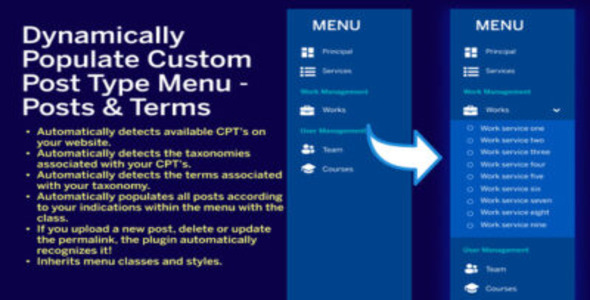Dynamically Populate Custom Post Type Menu

70+ Reviews
with 5 star Ratings

99% Customer
Satisfaction

7-Days
Money Back
Request update for this product.
$99.00 Original price was: $99.00.$4.99Current price is: $4.99.
- Version: Latest
- Last Updated: 02/09/2024
- License: Original
- Original License Activation
- Automatic Updates From WordPress Dashboard.
- 100% secure and verified downloads.
- Single Domain Usage
- We will Activate the License to Avoid Abuse
- We Purchase From the Original Developers
- Quick help through Email & Support Tickets
WordPress is an incredibly versatile platform, allowing users to create a wide range of websites from simple blogs to complex e-commerce stores. One of its powerful features is the use of custom post types (CPTs), which enable users to create and manage different types of content beyond the default posts and pages. However, managing and displaying these CPTs in your WordPress menus can sometimes be challenging. This is where dynamically populating a custom post type menu using a WordPress plugin comes into play.
In this article, we will explore the concept of dynamically populating custom post type menus in WordPress, why it’s beneficial, and how you can achieve it using a plugin.
Understanding Custom Post Types in WordPress
Before diving into dynamic menu population, it’s essential to understand what custom post types are and how they work in WordPress.
What Are Custom Post Types?
Custom post types are content types that go beyond the default WordPress post and page types. They allow you to create content that fits the specific needs of your website. For example, if you’re running a movie review website, you might create a custom post type called “Movies” to manage movie reviews separately from your blog posts.
Creating custom post types can be done manually by adding code to your theme’s functions.php file, or more easily, through a plugin like Custom Post Type UI.
Benefits of Using Custom Post Types
- Organization: Custom post types help organize content, making it easier for both admins and users to navigate the website.
- Flexibility: They provide the flexibility to create different content structures suited to your site’s needs.
- Customization: You can tailor custom post types to include specific fields, taxonomies, and metadata relevant to your content.
The Importance of Dynamic Menus in WordPress
Menus are crucial for guiding users through your website, providing them with a clear path to the content they seek. In a WordPress site with multiple custom post types, managing these menus manually can become cumbersome, especially as the site grows.
What Is a Dynamic Menu?
A dynamic menu automatically updates itself based on the content available on your site. For instance, if you add a new movie review to your “Movies” custom post type, a dynamic menu would automatically include that new post without requiring manual updates.
Why Dynamically Populate Menus?
- Time-Saving: Reduces the need for manual menu updates each time you add or remove content.
- Consistency: Ensures that all new content is instantly accessible through the site’s navigation.
- Error Reduction: Minimizes the risk of forgetting to add new content to the menu, which can lead to broken or incomplete navigation.
You must be logged in to post a review.




Reviews
Clear filtersThere are no reviews yet.